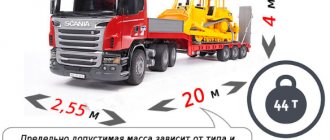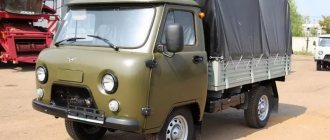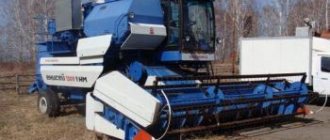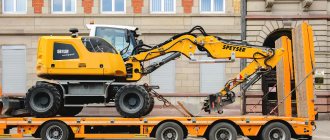Once upon a time, simple light trucks plied the roads, but today we see entire road trains on the roads. Transportation volumes are increasing, equipment is being produced more and more powerful. To maintain safety, the law provides for restrictions on the dimensions of road trains. Let's look at this issue in more detail, taking into account Russian and foreign experience.
In Australia:
Traffic rules
The maximum length of a road train according to current rules is twenty meters (with one trailer). The rules provide a clear explanation of the length. A single vehicle should not exceed twelve meters in length, a trailer for a vehicle should also not be longer than twelve meters, and the maximum length of a road train with a trailer, as we said above, should not be more than twenty meters in length.
It is important to say that the length of the road train also includes the length of the towbar (drawbar). For example, a truck is ten meters long, its trailer is also ten meters long, but do not forget that the trailer drawbar is two meters, so the total length of the road train will be twenty-two meters, not twenty meters. In this case, the maximum permissible length of the road train will be exceeded by two meters. This is a violation and should be taken into account.
The problem of length and attitude towards it
It is worth considering some of the provisions prescribed for road trains within the framework of the regulations adopted in the European Union. In particular, based on the specific Directive 96/95/EC and the subsequent amendments specifically made thereto, it is provided that:
- A value of 16.5 meters is set for the road train, as well as for the dimensions of the semi-trailer, within 12 meters from the axis of the fifth wheel coupling device, the position of the load will not allow the balance of the vehicle to be upset;
- This value is set taking into account that the length extends directly to the rear and at a level of no more than 2.04 meters to any point at the front of the structure;
- Based on these provisions, the corresponding “European standards” were formed, namely, for a semi-trailer, the length of which, together with a three-axle bogie, is no more than 13.6 meters. The truck tractor must have a wheel arrangement within 4x2 and be two-axle, which will maximize the high level of safety while driving on the road.
- Typical three-axle models with a wheel arrangement of 6x4 are also used, but this occurs exclusively as a chassis for construction, dump trucks, and special equipment, which is also regulated by the terms of the current legislation.
Other dimensions
But dimensions are not measured by length alone. We have found out the maximum length of the road train, now it’s time to talk about its other permissible dimensions. The rules clearly state that the width of the road train must fit within a dimension of 2.55 meters (2.6 meters for refrigerators and isothermal bodies). If we talk about height, there is a limit of four meters above the road surface.
It is allowed to transport cargo in road trains that protrudes two meters or less beyond the rear edge of the trailer. In addition, the movement of a road train with two or more trailers is allowed, but this is regulated by separate rules. This is a controversial issue, which we will touch on below.
Specifically about the load
Permissible axle loads are regulated and depend on the category of the road. We will provide more detailed data in tables.
Semi-trailers with single tires
| Axle type | Center distance | For roads designed for loads up to 6 t/axle | Load for roads up to 10 t/axle | Load for roads designed up to 11.5 t/axle |
| One | from 2.5 m | 5.5 t/axle | 9 t/axle | 10.5 t/axle |
| 2 close | up to 1 m | 8t/trolley | 10t/trolley | 11.5 t/trolley |
| 1-1.3 m | 9 t/trolley | 13 t/trolley | 14 t/trolley | |
| 1.3-1.8 m | 10t/trolley | 15 t/trolley | 17 t/trolley | |
| 1.8-2.5 m | 11 t/trolley | 17 t/trolley | 18 t/trolley | |
| 3 close | up to 1 m | 11 t/trolley | 15 t/trolley | 17 t/trolley |
| 1-1.3 m | 12t/trolley | 18 t/trolley | 20 t/trolley | |
| 1.3-1.8 m | 13.5 t/trolley | 21 t/trolley | 23.5 t/trolley | |
| 1.8-2.5 m | 15 t/trolley | 22 t/trolley | 25 t/trolley | |
| 4 or more close | up to 1 m | 3.5 t/axle | 5 t/axle | 5.5 t/axle |
| 1-1.3 m | 4 t/axle | 6 t/axle | 6.5 t/axle | |
| 1.3-1.8 m | 4.5 t/axle | 6.5 t/axle | 7.5 t/axle | |
| 1.8-2.5 m | 5 t/axle | 7 t/axle | 8.5 t/axle |
Semi-trailers with double tires
| One axis | from 2.5 m | 6 t/axle | 10 t/axle | 11.5 t/axle |
| 2 axes | up to 1 m | 9 t/trolley | 11 t/trolley | 12.5 t/trolley |
| 1 – 1.3 m | 10t/trolley | 14 t/trolley | 16 t/trolley | |
| 1.3 – 1.8 m | 11 t/trolley | 16 t/trolley | 18 t/trolley | |
| 1.8 – 2.5 m | 12t/trolley | 18 t/trolley | 20 t/trolley | |
| 3 close axes | up to 1 m | 12t/trolley | 16.5 t/trolley | 18 t/trolley |
| 1 – 1.3 m | 13 t/trolley | 19.5 t/trolley | 21 t/trolley | |
| 1.3 – 1.8 m | 15 t/trolley | 22.5 t/trolley | 24 t/trolley | |
| 1.8 – 2.5 m | 16 t/trolley | 23 t/trolley | 26 t/trolley | |
| 4 or more closely spaced axes | up to 1 m | 4 t/axle | 5.5 t/axle | 6 t/axle |
| 1 – 1.3 m | 4.5 t/axle | 6.5 t/axle | 7 t/axle | |
| 1.3 – 1.8 m | 5 t/axle | 7 t/axle | 8 t/axle | |
| 1.8 – 2.5 m | 5.5 t/axle | 7.5 t/axle | 9 t/axle |
Realities
We all know that traffic police officers do not miss the opportunity to communicate with the driver of a road train. Drivers say that there is always something in a road train that is a violation.
Although there are also drivers of road trains with whom there is simply no way to find fault. First of all, traffic police officers are interested in questions about whether the road train fits into the dimensions that apply in the country. This applies to weight, length, and everything else. You need to remember this and try not to give the traffic police officer a reason to issue a fine for any violations of the legal framework of our country.
Three-link road trains: history
Three-link road trains appeared a long time ago; it is believed that this option was first tested in Germany. At that time, there were no strict and rigid regulations that would concern the weight and length of road trains. Then everything was limited by the capabilities of technology.
In the early sixties of the last century, all of Europe adopted common and customary norms. But all carriers are very zealously striving to increase these existing parameters. This initiative arose in the late eighties of the twentieth century in Germany, then they managed to test several three-unit road trains on the roads of their country.
Three-link road trains: USSR and Russia
Old truck drivers and movie buffs of the USSR will remember that road trains with more than one trailer in their composition used to pass through the vastness of our country. Two or even three trailers were pulled behind them by activist drivers who were transporting grain. And at that time, conditional GAZ-53s were driving around the city, to which whole “beads” from barrels of kvass were attached. But after 1996, such road trains are no longer found on our roads.
There is a clause in the law that two or more trailers can be included in a road train if there is appropriate permission. But if everything were so simple, then such road trains would be found on highways in our time, but they are not. This means that everything is not so simple, and no one has abolished Russian bureaucracy with the collection of certificates and pieces of paper. It will probably be easier for a truck driver to make two trips than to collect all the necessary documents, unfortunately.
Three-link road trains: other countries
Today, in this matter, Holland is considered the most liberal country in Europe (this country has significant relaxations in legislation not only in road trains). There are five hundred three-link road trains in the country (length up to twenty-five meters, total weight sixty tons), mainly container transport.
There are also Scandinavians in Europe, they have always had their own norms in this regard. Previously, everything was limited to figures of twenty meters in length and fifty tons of total weight, then the figures grew to twenty-five meters and sixty tons, respectively. Today, the length of a road train should not exceed thirty meters, and the road train itself should be within seventy-six tons of total weight.
It is noteworthy that at one time a Finnish road train with two trailers was running around our country (the Helsinki-Moscow-Helsinki route), this happened under a special intergovernmental agreement between the two countries.
Today in Finland on internal roads you can see a road train consisting of two trailers of forty meters each or four trailers of twenty meters each. In Sweden they went even further. They are conducting an experiment and in it they are testing themselves in the field of a road train with a total weight of up to ninety tons!
In the USA, such transportation also occurs, the difficulty is that different US states have their own laws and regulations. Michigan State stands out above all others. Here you can see on the road a road train with a gross weight of up to eighty-six tons, but such road trains have many wheel axles to reduce the load on the road surface.
In Canada, Latin America and even Africa there are also “three-linkers”. And in Brazil you can find a combination that goes beyond reason! There are combinations in the country in which the permitted length of a road train is a respectable thirty meters, with a total weight of eighty tons!
But that is not all. In this matter, Australia was ahead of the rest. There are road trains here that are limited to one hundred and sixty tons! This figure simply amazes the consciousness of our truck driver, but in Australia no one is surprised by this.
No advantage
Freight traffic on city and regional highways has increased significantly, increasing the load on public roads and exposing the problem of overload. In pursuit of profit, careless carriers have a desire to transport as much cargo as possible, bypassing standards. For this reason, substantial fines from the Platon system fell on their heads.
“The permissible weight of a semi-trailer and the axle load are the main criteria for passing weight control on Russian roads.
The first indicator was established by the Decree of the Government of the Russian Federation of April 15, 2011 No. 272 “On approval of the rules for transporting goods by road” and contains the permissible weight of each piece of equipment used during transportation, depending on its design.
The permissible values of axial loads and the distances between them are also specified in Government Decree No. 272. According to the traffic rules (section 23), overloading a semi-trailer and failure to comply with the dimensions is subject to a fine, depending on the overweight indicators. For example, for a minimum overload of 2 to 10%, an individual can pay a fine of 1000-1500 rubles, a legal entity - from 100 to 150 thousand rubles. If the weight exceeds the maximum (over 50%), an individual may lose his rights for six months, and a legal entity may lose half a million rubles in sanctions for violation.
Considering the punishment, it is not profitable to violate weight standards,” explains Maxim Shishko, director of the commercial transport department of the AutoSpetsCenter Group of Companies.
Therefore, far-sighted businessmen choose semi-trailers according to the letter of the law and see benefits in this.
Director of Purchasing Transport Services at FM Logistic Eduard Mironov
“For our own FM Logistic fleet in Russia, we select semi-trailer equipment based on the characteristics of the cargo being transported (this applies to the refrigeration unit, the thickness of the walls and ceiling of the semi-trailer).
We also take into account the cost of vehicle ownership, which consists, among other things, of additional costs for repairs, maintenance of axles and their components, wear resistance of floors, as well as the residual price after 7 years of operation.
It is also important to eliminate the possibility of overweight on the axles of the semi-trailer already at the procurement planning stage, so the ability to track the load on the trolley in the tractor cabin at the time of loading and moving to the unloading place is extremely important for us,” says Eduard Mironov, director of procurement of transport services at FM Logistic.
The difficulties of Russia
As can be understood from the above, three-unit road trains are not uncommon in the world. What do we have? To be fair, let’s say that record road trains operate in countries with a favorable climate. Our asphalt is already in terrible condition, and if we set records on it with road trains, it will disappear altogether.
Yes, of course, our neighbors from the Scandinavian countries also live in a climate that is similar to our harsh northern regions, but the maximum permitted length of a road train in those countries is not decreasing, but only growing. But there is a drop of sadness in our country. We have no order, we have no roads, and without this we can’t get anywhere. Let's hope that everything will change for the better soon.
Roads of Russia
Every motorist knows that sometimes it is very difficult to overtake a road train on a regular road. What if the maximum length of a road train in Russia increases? Overtaking certainly won't be any easier. In European and Western countries, highways are wide and have at least two lanes for traffic in each direction. We have only a few such roads.
We also have places on the roads where it is simply impossible to maneuver a tractor if the maximum length of a road train in Russia is equal to that in Western countries. Unfortunately, our infrastructure is not yet ready for such events.
The longest road train in the world
Australia is the champion in organizing the longest road trains in the world. Due to the unpopularity and small number of railways on the continent, road freight transportation is in great demand. It was Australia that has repeatedly broken the record for creating the largest automobile composition.
Since 1999, the Australians have tried to attach as many trailers to the tractor as possible. The absolute record was broken in 2006, when they managed to assemble a road train slightly less than 1.5 kilometers long. There were 112 trailers attached to the tractor. The total mass of the “tail” was 1300 tons. True, there was no record for transportation distance: the road train transported it only 140 meters.
Author: TECHNOmagazine
Share
Russian car fleet
But we can’t just blame our government for the fact that our roads are not ready for this, that the infrastructure is not ready, that the bridges will not withstand, and so on. We need to say a little about ourselves. After all, if something is allowed to a Russian person, then he begins to use it without hesitation.
Just imagine the situation in which in our country they will be allowed to drive multi-unit road trains without any problems. And then our fictional private truck driver will buy himself an old KAMAZ or MAZ, which was assembled in the dawn of USSR times, and hook a couple of trailers to it, then he will load everything to capacity in order to somehow meet the norm, and will go out onto the highway. How safe will this be for the driver and other road users?
The problem must be solved as a whole, and not point the finger at other countries and say that they can do it, even if we can do it too. But complex solutions to problems take time and money. Both time and funds are required colossal.
General requirements for transportation
What are the features of a rental agreement for a vehicle with a crew
? The requirements that a driver transporting cargo must fulfill are set out in Chapter 23 of the Russian Road Rules. According to the rules, the machine cannot be overloaded. Exceeding the permissible loads can lead to vehicle breakdown, but law enforcement agencies are more concerned about other road users.
Due to excessive load:
- the maneuverability of the machine is reduced;
- the center of gravity shifts;
- braking distance increases.
Before driving, the driver must ensure that the load is secured securely. While driving, luggage on the roof experiences serious load from the oncoming air flow and its fall can create an emergency situation.
When placing cargo on the roof, several rules must be followed:
- it should not block the driver’s view;
- luggage should not cover indicator lights and numbers;
- the load should not affect the control process;
- it should not affect the stability of the car.
If it is impossible to place luggage on the roof taking into account these requirements, then movement cannot begin.
Toll roads
Perhaps toll roads will be the solution. Theoretically, powerful, reliable toll roads, which have several lanes in each direction and modern, well-thought-out infrastructure, could be the initial solution for Russia.
Private carriers may begin to use toll roads to make even more profit from their shipments. But let’s not forget how difficult innovation is in our country. Not so long ago, this could be seen when the “PLATON” system was introduced for heavy vehicles. Although in European countries and the West, similar systems exist and have been operating for a very long time. In our country, everyone wants to get everything at once and preferably for free. This has been the practice since ancient times and continues to this day.
Loopholes
Some thematic forums have the following interesting information, let's look at it with an example. The maximum permitted length of a road train is regulated in our country. And it is almost impossible to obtain permission to include two trailers in a road train. But our drivers found a way out.
You cannot attach two trailers to a conventional KAMAZ, but the same KAMAZ can tow a broken KAMAZ with a trailer. Why don't you like a long road train that fits into our strange current legislation? Of course, no one claims that the traffic police will not realize that you are being cunning.
Although on these thematic forums where this information was taken, there are users who say that they use this scheme quite successfully. Let's hope this is true and not their imagination and boasting.
Truck brands
Manufactured outside of Russia and the CIS
- Ashok Leyland
- Astra (eng. Astra)
- Avia
- Bei Ben Heavy-Duty Truck
- BMC
- Bremach
- CAMC
- Changan
- Chery
- Chevrolet
- Citroen
- CNHDT
- DAF
- Dayun
- Dongfeng
- ED Truck
- FAW
- Fiat
- Foden
- Ford
- Foton
- Freightliner
- GMC
- Great Wall
- Hino Motors
- Hyundai
- Isuzu
- Iveco
- J.A.C.
- Jelcz
- J.M.C.
- Kenworth
- Kia
- Lifan
- Mack
- MAN
- Mazda
- Mercedes-Benz
- Mitsubishi
- Multicar
- Navistar
- Nissan
- Opel
- Peugeot
- Peterbilt
- Piaggio
- RAM
- Renault
- Renault Trucks
- SAIC
- Scania
- Sisu
- Shaanxi
- Sonacome
- Tata
- Tatra
- Terberg
- Tesla
- Toyota
- Vauxhall
- Volkswagen
- Volvo
- Western Star
Produced in Russia and the CIS
Dimensions and load capacity of trucks
According to the actual situation at the beginning of 2022, the following brands of trucks were produced in Russia and the CIS countries:
- Avtotor (Kaliningrad) - SKD assembly of trucks of the Kia brands (discontinued), SKD (since 2011) and CKD (since November 2022) assembly of the Hyundai brand, TATA-Daewoo (SKD assembly in 2015 was limited to single copies), joint with Ford Otosan manufactured by Ford Trucks.
- BAZ (Bryansk Automobile Plant) / another name BZKT (Bryansk Wheel Tractor Plant) - since 1966 (in 1993-1996, limited production of the 1.5-ton LCV model BAZ-3778)
- BelAZ (Belarusian Automobile Plant) - since 1958
- VIS (VazInterService, Sok group, AVTOVAZ) - since 1994 (since 2014 as part of AVTOVAZ)
- Volvo (Volvo Vostok) (Zelenograd) - since 2003, (Kaluga) - since 2010.
- GAZ (Gorky Automobile Plant, GAZ Group) - since 1932
- Mitsubishi Fuso (DAIMLER KAMAZ RUS, formerly Mitsubishi Fuso RUS - since 2011 (CKD assembly of Mitsubishi Fuso Canter)
- IVECO-UralAZ (together with Iveco) - since 1992
- ISUZU ISUZU RUS, formerly SOLLERS-ISUZU - since 2006.
- KAMAZ (Kama Automobile Plant) (Naberezhnye Chelny) - since 1976
- KrAZ (Kremenchug Automobile Plant) - since 1959
- MAZ (Minsk Automobile Plant) - since 1947
- MAZ-MAN (together with MAN AG) - since 1998
- MAH (MAN RUS) - since 2014
- Mercedes-Benz DAIMLER KAMAZ RUS, formerly MBTV (together with Daimler AG) (Naberezhnye Chelny) - since 2010
- MZKT (Minsk Wheel Tractor Plant) - since 1991 (in 1954-1991 - a division of MAZ)
- NefAZ (Neftekamsk Automobile) - since 1977
- Renault Trucks (Kaluga) - since 2009
- SAZ (Saransk Dump Truck Plant) (GAZ Group) - since 1960
- Scania (Scania RUS), formerly Scania-Peter (Shushary) - since 2010
- Tonar (Machine-Building) (Likino-Dulyovo) - since 2011 (as a manufacturer of trailers - since 1990)
- UAZ (Ulyanovsk Automobile) - since 1942
- Ural (AZ "Ural" (Miass), (GAZ Group) - since 1944
- Ford (Ford Sollers Elabuga) - since 2014
Previously produced
The following brands of trucks were previously produced in Russia and the CIS countries, but their production was discontinued:
- AMUR (“Cars and Motors of the Urals” (Novouralsk) - since 1977 as UAMZ (a branch of ZIL), since 2004 as AMUR (production of trucks was curtailed in 2012)
- ZIL (AMO ZIL (Moscow)) - 1916-2016. (in 2015, the company was declared bankrupt; production of trucks was curtailed in 2016)
- ZIL-MMZ (Metrovagonmash (Mytishchi, Vyshny Volochek)) - 1947-2013. (production of dump trucks on the ZIL chassis ceased in 2013)
- Izh (IzhAvto, Sok group, AVTOVAZ) - since 1968 (production of the Izh-27175 LCV was discontinued in 2012, now the company is called LADA Izhevsk)
- KZKT (Kurgan Wheeled Tractor Plant) - 1950 (in 2011 the enterprise was declared bankrupt, actual production of off-road wheeled tractors was discontinued in 2009)
- Yarovit (production of the Leningrad Metal Plant) - since 2004 (in fact, the production of Yarovit cars was stopped in 2013)
Modular road train of the future
The future is already here. Today, the development of the so-called modular road train is actively underway. There are some developments that are already close to testing and implementation in real conditions.
The idea is that the driver sits in the first heavy truck, and behind this heavy truck there are, for example, five more heavy trucks. These five cars are controlled by computer and automation. They essentially copy the behavior and trajectory of a car with a driver.
In fact, we have six separate heavy-duty trucks that easily fit into any size standards and requirements and only one driver. Of course, multi-lane roads are needed for such purposes, but the idea itself is interesting and attractive.
There are also such developments that a driver will not be required in the first lead vehicle. And all this will be extremely safe. This is a big step forward for freight transport in the world. Let's see how quickly all this is implemented, implemented and taken root.
Again, it seems that our country will not become a platform for pilot projects to test such innovative innovations, but, of course, every modern car enthusiast wants to follow this situation.










